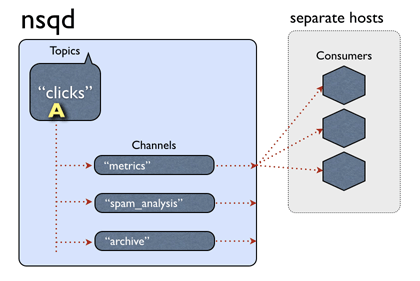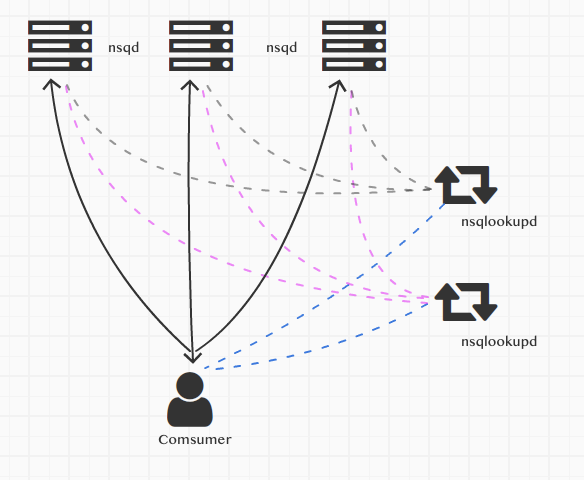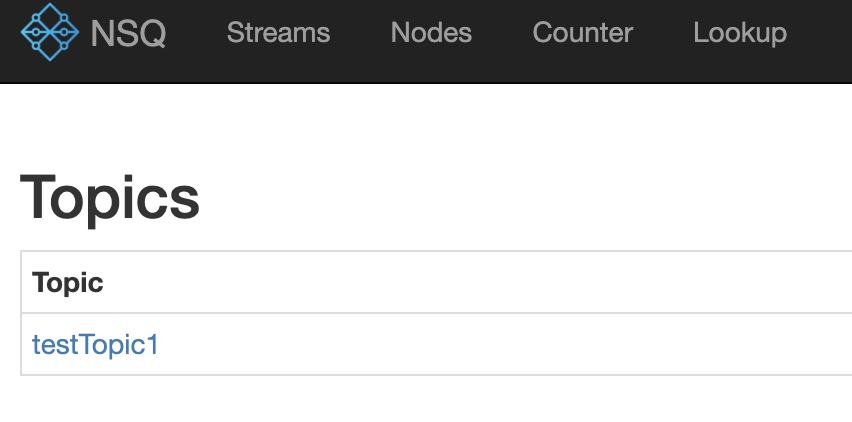分布式消息队列nsq,简单易用,去中心化的设计使nsq更健壮,nsq充分利用了go语言的goroutine和channel来实现的消息处理,代码量也不大,读不了多久就没了。后期的文章我会把nsq的源码分析给大家看。
主要的分析路线如下
- 分析
nsq的整体框架结构,分析如何做到的无中心化分布式拓扑结构,如何处理的单点故障。 - 分析
nsq是如何保证消息的可靠性,如何保证消息的处理,对于消息的持久化是如何处理和扩展的。 - 分析
nsq是如何做的消息的负载处理,即如何把合理的、不超过客户端消费能力的情况下,把消息分发到不同的客户端。 - 分析
nsq提供的一些辅助组件。
这篇帖子,介绍nsq的主体结构,以及他是如何做到去中心化的分布式拓扑结构,如何处理的单点故障。
几个组件是需要先大概说一下nsqd 消息队列的主体,对消息的接收,处理和把消息分发到客户端。nsqlookupd nsq拓扑结构信息的管理者,有了他才能组成一个简单易用的无中心化的分布式拓扑网络结构。go-nsq nsq官方的go语言客户端,基本上市面上的主流编程语言都有相应的客户端在这里
还有可视化的组件nsqadmin和一些工具像nsq_to_file、nsq_stat、等等,这些在后期的帖子里会介绍

nsqd是独立运行的,我们可以直接使用部署几个nsqd然后使用客户端直连的方式使用

目前资源有限,我就都在一台机器上模拟了
启动两个nsqd
./nsqd -tcp-address ":8000" -http-address ":8001" -data-path=./a
./nsqd -tcp-address ":7000" -http-address ":7001" -data-path=./b
正常启动会有类似下面的输出
[nsqd] 2019/08/29 18:42:56.928345 INFO: nsqd v1.1.1-alpha (built w/go1.12.7) [nsqd] 2019/08/29 18:42:56.928512 INFO: ID: 538 [nsqd] 2019/08/29 18:42:56.928856 INFO: NSQ: persisting topic/channel metadata to b/nsqd.dat [nsqd] 2019/08/29 18:42:56.935797 INFO: TCP: listening on [::]:7000 [nsqd] 2019/08/29 18:42:56.935891 INFO: HTTP: listening on [::]:7001
简单使用
func main() { adds := []string{"127.0.0.1:7000", "127.0.0.1:8000"} config := nsq.NewConfig() topicName := "testTopic1" c, _ := nsq.NewConsumer(topicName, "ch1", config) testHandler := &MyTestHandler{consumer: c} c.AddHandler(testHandler) if err := c.ConnectToNSQDs(adds); err != nil { panic(err) } stats := c.Stats() if stats.Connections == 0 { panic("stats report 0 connections (should be > 0)") } stop := make(chan os.Signal) signal.Notify(stop, os.Interrupt) fmt.Println("server is running....") <-stop } type MyTestHandler struct { consumer *nsq.Consumer } func (m MyTestHandler) HandleMessage(message *nsq.Message) error { fmt.Println(string(message.Body)) return nil } 方法 c.ConnectToNSQDs(adds),连接多个nsqd服务
然后运行多个客户端实现
这时,我们发送一个消息,
curl -d 'hello world 2' 'http://127.0.0.1:7001/pub?topic=testTopic1'
nsqd会根据他的算法,把消息分配到一个客户端
客户端的输入如下
2019/08/30 12:05:32 INF 1 [testTopic1/ch1] (127.0.0.1:7000) connecting to nsqd 2019/08/30 12:05:32 INF 1 [testTopic1/ch1] (127.0.0.1:8000) connecting to nsqd server is running.... hello world 2
但是这种做的话,需要客户端做一些额外的工作,需要频繁的去检查所有nsqd的状态,如果发现出现问题需要客户端主动去处理这些问题。
我使用的客户端库是官方库 go-nsq,使用直接连nsqd的方式,
- 如果有
nsqd出现问题,现在的处理方式,他会每隔一段时间执行一次重连操作。想去掉这个连接信息就要额外做一些处理了。 - 如果对
nsqd进行横向扩充,只能是自己民额外的写一些代码调用ConnectToNSQDs或者ConnectToNSQD方法
官方推荐使用连接nsqlookupd的方式,nsqlookupd用于做服务的注册和发现,这样可以做到去中心化。

图中我们运行着多个nsqd和多个nsqlookupd的实例,客户端去连接nsqlookupd来操作nsqd
我们要先启动nsqlookupd,为了演示方便,我启动两个nsqlookupd实例, 三个nsqd实例
./nsqlookupd -tcp-address ":8200" -http-address ":8201"
./nsqlookupd -tcp-address ":7200" -http-address ":7201"
为了演示横向扩充,先启动两个,客户端连接后,再启动第三个。
./nsqd -tcp-address ":8000" -http-address ":8001" --lookupd-tcp-address=127.0.0.1:8200 --lookupd-tcp-address=127.0.0.1:7200 -data-path=./a
./nsqd -tcp-address ":7000" -http-address ":7001" --lookupd-tcp-address=127.0.0.1:8200 --lookupd-tcp-address=127.0.0.1:7200 -data-path=./b
--lookupd-tcp-address 用于指定lookup的连接地址
客户端简单代码
package main import ( "fmt" "os" "os/signal" "time" "github.com/nsqio/go-nsq" ) func main() { adds := []string{"127.0.0.1:7201", "127.0.0.1:8201"} config := nsq.NewConfig() config.MaxInFlight = 1000 config.MaxBackoffDuration = 5 * time.Second config.DialTimeout = 10 * time.Second topicName := "testTopic1" c, _ := nsq.NewConsumer(topicName, "ch1", config) testHandler := &MyTestHandler{consumer: c} c.AddHandler(testHandler) if err := c.ConnectToNSQLookupds(adds); err != nil { panic(err) } stats := c.Stats() if stats.Connections == 0 { panic("stats report 0 connections (should be > 0)") } stop := make(chan os.Signal) signal.Notify(stop, os.Interrupt) fmt.Println("server is running....") <-stop } type MyTestHandler struct { consumer *nsq.Consumer } func (m MyTestHandler) HandleMessage(message *nsq.Message) error { fmt.Println(string(message.Body)) return nil } 方法ConnectToNSQLookupds就是用于连接nsqlookupd的,但是需要注意的是,连接的是http端口7201和8201,库go-nsq 是通过请求其中一个nsqlookupd的 http 方法http://127.0.0.1:7201/lookup?topic=testTopic1 来得到所有提供topic=testTopic1的nsqd 列表信息,然后对所有的nsqd进行连接,
2019/08/30 13:47:26 INF 1 [testTopic1/ch1] querying nsqlookupd http://127.0.0.1:7201/lookup?topic=testTopic1 2019/08/30 13:47:26 INF 1 [testTopic1/ch1] (li-peng-mc-macbook.local:7000) connecting to nsqd 2019/08/30 13:47:26 INF 1 [testTopic1/ch1] (li-peng-mc-macbook.local:8000) connecting to nsqd
目前我们已经连接了两个。
我们演示一下横向扩充,启动第三个nsqd
./nsqd -tcp-address ":6000" -http-address ":6001" --lookupd-tcp-address=127.0.0.1:8200 --lookupd-tcp-address=127.0.0.1:7200 -data-path=./c
这里会有一个问题,当我启动了一个亲的nsqd但是他的topic是空的,我们需指定这新的nsqd处理哪些topic。
我们可以用nsqadmin查看所有的topic
./nsqadmin --lookupd-http-address=127.0.0.1:8201 --lookupd-http-address=127.0.0.1:7201

然后去你的nsqd上去建topic
curl -X POST 'http://127.0.0.1:6001/topic/create?topic=testTopic1'
当然也可以自己写一些自动化的角本
查看客户端的日志输出
2019/08/30 14:56:01 INF 1 [testTopic1/ch1] querying nsqlookupd http://127.0.0.1:7201/lookup?topic=testTopic1 2019/08/30 14:56:01 INF 1 [testTopic1/ch1] (li-peng-mc-macbook.local:6000) connecting to nsqd
已经连上我们的新nsqd了
我手动关闭一个nsqd实例
客户端的日志输出已经断开了连接
2019/08/30 15:04:20 ERR 1 [testTopic1/ch1] (li-peng-mc-macbook.local:8000) IO error - EOF 2019/08/30 15:04:20 INF 1 [testTopic1/ch1] (li-peng-mc-macbook.local:8000) beginning close 2019/08/30 15:04:20 INF 1 [testTopic1/ch1] (li-peng-mc-macbook.local:8000) readLoop exiting 2019/08/30 15:04:20 INF 1 [testTopic1/ch1] (li-peng-mc-macbook.local:8000) breaking out of writeLoop 2019/08/30 15:04:20 INF 1 [testTopic1/ch1] (li-peng-mc-macbook.local:8000) writeLoop exiting 2019/08/30 15:04:20 INF 1 [testTopic1/ch1] (li-peng-mc-macbook.local:8000) finished draining, cleanup exiting 2019/08/30 15:04:20 INF 1 [testTopic1/ch1] (li-peng-mc-macbook.local:8000) clean close complete 2019/08/30 15:04:20 WRN 1 [testTopic1/ch1] there are 2 connections left alive
并且nsqd和nsqlookupd也断开了连接,客户端再次从nsqlookupd取所有的nsqd的地址时得到的总是可用的地址。
nsqlookupd用于管理整个网络拓扑结构,nsqd用他实现服务的注册,客户端使用他得到所有的nsqd服务节点信息,然后所有的consumer端连接
实现原理如下,
nsqd把自己的服务信息广播给一个或者多个nsqlookupd客户端连接一个或者多个nsqlookupd,通过nsqlookupd得到所有的nsqd的连接信息,进行连接消费,- 如果某个
nsqd出现问题,down机了,会和nsqlookupd断开,这样客户端从nsqlookupd得到的nsqd的列表永远是可用的。客户端连接的是所有的nsqd,一个出问题了就用其他的连接,所以也不会受影响。
来源:博客园
作者:li-peng
链接:https://www.cnblogs.com/li-peng/p/11435083.html